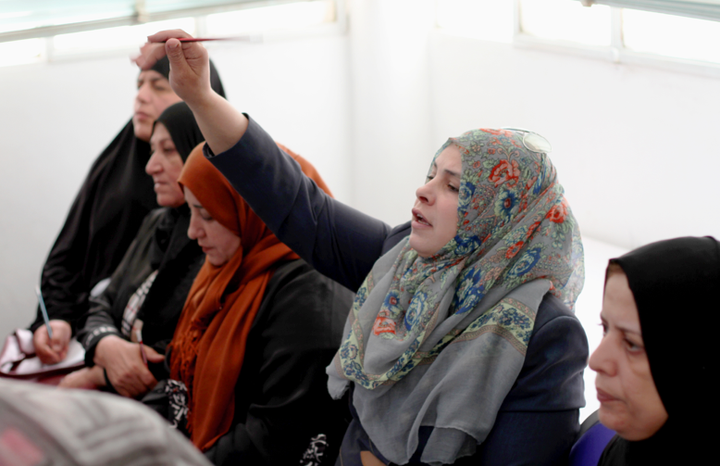
How can we improve women’s access to economic opportunities in the Arab world? And more importantly, their access to entrepreneurial activities? If you don’t have an immediate answer, don’t worry; there is no simple answer to it. This is a question that development practitioners have been trying to explore and answer for decades.
Achieving gender equality and empowering women and girls lead many of the discussions happening in the international development arena today, and rightly is a priority in realizing our Sustainable Development Goals. Because of the spotlight being shone on this important issue, best practices to improve women’s access to economic opportunities not only in the Middle East, but also globally, are steadily on the rise.
To begin to address this age-old question, we must examine the challenges and barriers being faced by women and girls today so that we can overcome them, and recognise success stories where positive shifts in women’s access to economic opportunities are occurring over time.
One of the main obstacles development practitioners face is the significant lack of quantitative[1] and qualitative[2] information collected and recorded on the number, growth, and characteristics of women-owned enterprises in the Arab world. Without this data, there is little to inform best practices and policy making.
Further, it is important that we do not generalize our approach when addressing this issue, even regionally, as the economic climate, policies, and practices differ. The gender development index (GII), inequality in the distribution of family income index (GINI), human development index (HDI), and many other indexes and rankings show vast disparities and diversity across Arab countries—and even within each country. Entrepreneurs in Egypt and Tunisia—where economic activities tend to be factor-driven—heavily depend on the basis of price as they buy and sell basic products. This leaves them highly sensitive to the global economy and fluctuations in exchange rates. Conversely, in Lebanon and Morocco, economic activities are often efficiency-driven—focused more on efficient and advanced production processes and increased product quality[3].
Lastly, there is a clear lack of evidence and debate surrounding the correlation between gender equality, women’s empowerment, and women’s entrepreneurship in the Arab world.
Through my work personally and professionally across six countries in the Middle East, I have explored ways to better understand how to foster women’s entrepreneurship and have noticed four key trends and observations that have shown a promising impact.
1. Factoring gendered social norms in any intervention leads to a better understanding and improved approaches. In a recent experience in the West Bank, a project I was involved in intended to create systemic change in support of women entrepreneurs that included a focus on policy change and advocacy. In order for this project to truly succeed, we assumed that laws and policies, financing strategies, and access to business skills must be more conducive to women’s entrepreneurship. Our assumptions were true and our strategy was impactful, but we lacked a deeper understanding of gendered social norms and how they affect women’s economic engagement. Focus groups with women entrepreneurs highlighted that gendered social norms can hinder women’s access to entrepreneurial activities, impede their access to business growth and control over income and resources, and reduce the impact of essential structural and skill-building interventions. Although women are not necessarily disempowered if they conform to social norms, significant barriers to economic activity are seen as a result of these norms—especially with regard to gendered decision-making, restrictions on mobility and ownership norms, acceptance of gender-based violence, and segregation of sectors and tasks. Similar findings in various operations emphasize the importance of identifying, assessing, and addressing social norms affecting women’s economic empowerment.[4] Strategies are often indirect by assuming that expected economic benefits for women will change social norms over time. However, intentional direct efforts to shift social norms—such as community and household dialogue, support groups, and awareness campaigns to confront gender inequality—is possible and encouraged.
2. Localization and community-ownership is key to achieve a success. Emergent models are increasingly moving into macro-level interventions that address policy areas such as enabling business environments, the role of the private sector, and the role of key supporting organizations in the market (i.e. the chambers of commerce and industries, business development service providers, and financial institutions[5]). These approaches can help accelerate and nurture a systemic change that is sustainable and with high potential for replication and multiplication. However, it is important to note that the role of civil society organizations should not be undermined. Building the capacity of civil society organizations to reach out and deliver or facilitate programs that are supportive of women’s entrepreneurship can yield multiple benefits: (1) they are able to reach out to hard-to-reach groups and ensure the inclusion of excluded or marginalized women, (2) they can address security, safety, and gender-based violence risks experienced by women entrepreneurs in the household, workplace, or in the market, (3) they are able to facilitate the creation of support and network platforms that enable women entrepreneurs to access social and economic resources in a safe, supportive, and inclusive environment, and (4) they help facilitate the replication of impact in new communities that have limited access to information, infrastructure, and public/private services.
3. Economic inclusion is a priority, but it has to be facilitated by developing and evidencing innovative models. I have been recently involved in the development of several micro-franchising[6] models in Morocco, West Bank, Sudan, and Armenia. Micro-franchising is often seen as a way to enable entrepreneurs with low-income, resources, and limited business skills to own and benefit from sound and established business models. It is similar to commercial franchising models but with an explicit social aim—to facilitate business creation with a modest investment requisite at a smaller scale with less of a risk that low-income people can afford. However, micro-franchising should also be seen as a way to promote the inclusion of women entrepreneurs in high-growth and high-value business opportunities, encourage their economic integration, and provide them with equal access to economic resources. Other replicable models have shown a great impact, such as the Near East Foundation’s community-based “Siraj” business centres and savings and loan associations in Jordan and Lebanon that facilitate the economic inclusion of women and men—refugees and poor host communities—in local economies. NEF’s flexible community-based business incubators in Palestine, Morocco, and Sudan—that focus on product and process innovation and upgrade in incremental and iterative ways—have the potential to lower business risk and investment costs for women entrepreneurs, eventually increasing women’s access to high-growth business opportunities. Other models should be trialled, assessed, improved, and evidenced. They require collective and systematic effort across regions and organisations.
4. Promoting women’s entrepreneurship should build women’s capacity to make decisions and act on economic opportunities. Women’s economic prosperity should not be assumed to equal women’s empowerment or financial independence. For example, women’s entrepreneurship and increased income may hinder women’s decision making power on the household level and may increase the risk for domestic violence or expose them to higher gender-based violence risk in the marketplace. To prevent this, and to reduce and address these risks, economic development programs require a holistic approach at the household, community, market, and policy levels. This may involve advocacy, awareness, education, and engagement of all members of the household and society in debates and actions around these issues. It also requires that interventions assist women entrepreneurs to consider, assess, and respond to those risks. For example, by embedding safety mapping tools and gender-based violence risk assessments into business planning.
These observations and recommendations may not be totally new for many development practitioners and decision makers—and definitely are not all-inclusive—but they are important to consider when designing or implementing programs that aim to improve women’s access to economic opportunities in the Arab world.
So where does this leave us?
The argument I often hear is that with limited resources and an increased focus on value-for-money we need to prioritize, and potentially compromise. However, value-for-money and limited resources are indeed the counter-arguments for why we should consider such topics. If we don’t consider them, we may risk reducing the impact, sustainability, and potential scale and replication of such interventions; risk reducing the level of investment (which is on the rise); and more importantly, we may limit the manifold personal, social, and economic benefits that entrepreneurship can yield for women and their families, communities, and economies in the Arab world.
Equal access to economic opportunities for women requires us to look at the Syrian refugee crisis from a different angle. Preventing access to economic opportunities in Lebanon for Syrian refugees, for example, must be challenged if we want to apply the same economic inclusion principles we are advocating. Access to economic opportunities should be extended to Syrian women refugees—and all refugees.
Finally, it is important not to assume that women’s economic development can lead to women’s empowerment and gender equality. The opposite is not true either. The correlation between them is very strong though[7]. Lack of access to and control over resources, gendered inequitable laws and practices, gendered social norms, women’s time-use and similar rights, empowerment, and equality factors are vital to consider in economic development programs.
Collectively, women’s voice and influence in the community will be improved, their confidence will increase, and their participation in community affairs and decision-making will expand; which are all significant development challenges in the Arab world that need to be addressed, with the aim that, collectively, they will strengthen women’s rights and promote economic growth in the Arab world.
To see this theory in action, watch the Near East Foundation’s recent video that highlights three women in Lebanon who took action to rebuild their lives.
1]http://www.ifc.org/wps/wcm/connect/e3a45180488553abaff4ff6a6515bb18/MENA_Women_Entrepreneurs_ExecSum_English.pdf?MOD=AJPERES&CACHEID=e3a45180488553abaff4ff6a6515bb18
[2] GEM 2015 SPECIAL REPORT Women’s Entrepreneurship
[3] GEM 2013, 2015, 2016 Global Report
[4] https://beamexchange.org/uploads/filer_public/70/03/70036ac2-134d-4f78-a89b-e72033b9b7f9/socialnorms-policybrief.pdf
[5] http://www.enterprise-development.org/implementing-psd/
[6] http://ssir.org/articles/entry/a_good_business_for_poor_people
[7] DAC Network on Gender Equality. (2011). ‘Women’s Economic Empowerment: Issues Paper’, OECD Publishing, Paris
Kabeer, N., Mahmud, S. and Tasneem, S. (2011). ‘Does Paid Work Provide a Pathway to Women’s Empowerment? Empirical Findings from Bangladesh’, Working Paper 375, IDS, Brighton
WOMEN’S ECONOMIC EMPOWERMENT: PUSHING THE FRONTIERS OF INCLUSIVE MARKET DEVELOPMENT, LEO 2015, http://www.enterprise-development.org/wp-content/uploads/WEE_in_Market_Systems_Framework_final.pdf
